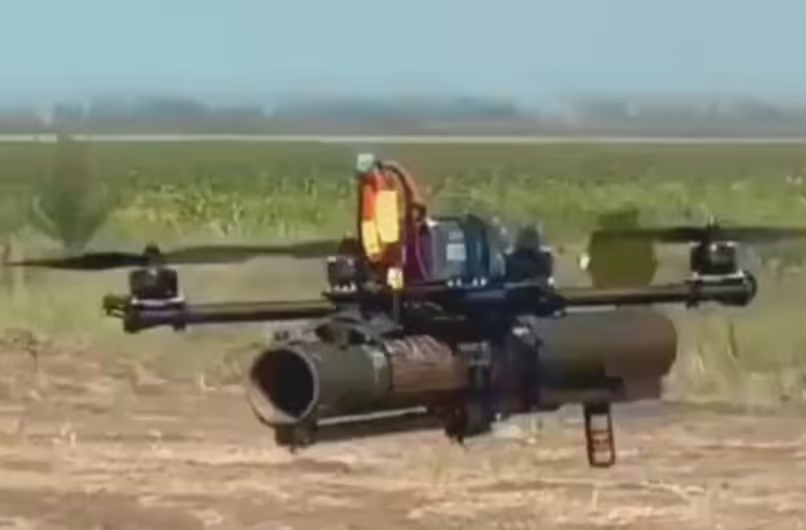
Ukraine Turns Drones into Soviet-era RPG-18 Missile Launchers
In the midst of an ongoing conflict, Ukraine is pushing the boundaries of unmanned warfare. A recent development has seen the country repurposing quadcopter drones to carry Soviet-era RPG-18 Mukha anti-tank missile launchers.
This innovation aims to provide a more cost-effective solution for targeting Russian tanks, infantry fighting vehicles, and howitzers. By integrating RPG-18 launchers with drones, Ukraine hopes to enhance its strategic capabilities on the battlefield.
Undergoing Testing
In a video circulated on social media, Ukraine showcased the flight test of this anti-tank unmanned aerial vehicle (UAV). The drone was seen performing well during the trial, but it might face challenges in long-range operations due to the 2.6 kg weight of the RPG-18 Mukha rocket launcher. Given Ukraine’s success with new types of drones, it is plausible this UAV will be deployed soon.
The drone is likely to be employed for short-range operations, launching anti-tank missiles from higher elevations to target Russian positions. This approach offers a more affordable solution for Ukraine to hit Russian tanks, infantry fighting vehicles, and howitzers. Equipped with a state-of-the-art guidance system and a high-resolution nano camera, the drone can achieve high precision in targeting.
RPG-18 Mukha
The RPG-18 Mukha (Russian: Муха, romanized: Fly) is a Soviet short-range, disposable light anti-t tank rocket launcher. It is similar to the US M72-series LAW anti-tank rocket launcher. The RPG-18 fires a 64 mm PG-18 HEAT warhead capable of engaging targets within 200 meters. The warhead self-destructs 6 seconds after launch, limiting its range even if used effectively with targets beyond 200 meters.
Although the RPG-18 can penetrate up to 375 mm of conventional armor, its effectiveness diminishes against targets protected by High-explosive anti-tank (HEAT) resistant explosive reactive armor (ERA) or composite armor. It requires only one operator, making it distinct from other reloadable RPG systems that need assistant grenadiers.
The RPG-18 launcher consists of an extruded plastic-fiber outer tube and a telescopically joined aluminum inner tube. Being a disposable single-shot weapon, no loading or reloading of ammunition is required. The firing mechanism is mechanical and differs from the US M72 series.
[twitter-embed-display twitter_url=’https://twitter.com/GoogleDeepMind/status/1834232555396018464′]
Technological Advancements in Ukrainian Drones
Ukraine continues to develop innovative drone technology. Recently, Ukrainian President Volodymyr Zelenskyy unveiled a long-range drone missile, named the “Palianytsia,” developed domestically in less than 18 months.
In the past few weeks, the Ukrainian Armed Forces have introduced the ‘dragon drone,’ which fires incendiary weapons designed to ignite military equipment concealed under vegetation. This is part of Ukraine’s broader strategy to enhance its unmanned capabilities and address the evolving battlefield conditions.
These advancements signify Ukraine’s commitment to leveraging technology to gain a tactical advantage against Russian forces.
Strategic Implications
The integration of RPG-18 launchers into drones represents a strategic milestone for Ukraine. It offers a cost-effective solution for targeting various Russian military assets, including tanks and infantry fighting vehicles.
By utilizing drones for these missions, Ukraine can minimize the risk to its ground forces while maintaining pressure on Russian positions. The high precision of drones equipped with advanced guidance systems and cameras also increases the likelihood of successful hits.
Challenges and Considerations
While the innovation is promising, there are challenges to be addressed. The weight of the RPG-18 Mukha limits the drone’s range and operational flexibility.
Ukraine must also consider the potential countermeasures from Russian forces. As both countries continue to evolve their unmanned capabilities, the effectiveness of such innovations may be tested on the battlefield.
Despite these challenges, the potential benefits of integrating RPG-18 launchers with drones could outweigh the difficulties, providing Ukraine with a valuable tool in its military arsenal.
Global Reactions and Future Prospects
The global community is closely monitoring Ukraine’s advancements in drone technology. Many military experts believe that the integration of RPG-18 launchers into drones could change the dynamics of modern warfare.
Future prospects for this technology seem promising, with potential modifications and enhancements to improve performance. Ukraine’s efforts could serve as a model for other countries looking to innovate in unmanned warfare.
As these developments unfold, the world will watch closely to see how Ukraine’s strategic innovations impact the ongoing conflict and the broader context of military technology.
Ukraine’s integration of RPG-18 missile launchers into drones marks a significant step in modern warfare. This development not only improves their tactical capabilities but also sets a precedent for future innovations in unmanned systems.
As the conflict continues, such technological advancements could play a crucial role in determining the outcomes on the battlefield. Ukraine’s ability to adapt and innovate underscores the evolving nature of modern military strategy.
Source: Interestingengineering – Youtube – Twitter
- September 14, 2024
- 535
- Engineering
- 0 comment







Add Comment